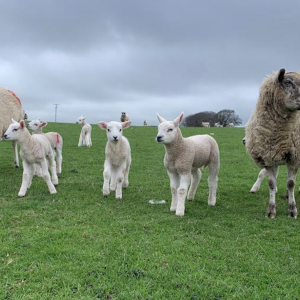
By Vet Annie Kerr
Coccidia are single cell parasites that infect the gut wall causing damage and reducing the ability of the wall to process and absorb nutrients.
This leads to scour (which may be bloody), dehydration and weight loss.

There are several species that infect sheep, and they are host-specific ie they only infect sheep.
Two of these species are pathogenic (Eimeria ovinoidalis and Eimeria crandallis) and can cause severe disease, whereas other species are relatively benign.
This means that counts of coccidia eggs (oocysts) are a very blunt tool in managing the disease unless you are aware of the species involved. Fortunately, speciation can be performed by many laboratories informing any decisions to treat and what level of oocysts is significant on farm.
Coccidial oocysts are very resistant and can persist in the environment for long periods including overwintering on pasture. Build-up of oocysts occurs in areas of high stocking density, particularly if these are damp, so ground around creep feeders and indoor lambing pens at the end of the season are particular areas of risk.
At the start of lambing there will be fewer oocysts and lambs born at this time may not develop clinical signs until they are older, if at all.
They can however be shedding oocysts and contaminating the environment so later born lambs pick up significant infections at a younger age, which can be exacerbated if one field is used for turnout of ewes and lambs for an entire season.
Ewes carry low numbers of oocysts and it used to be suggested that treatment of the ewe prior to lambing would reduce environmental contamination and lamb infection. This is no longer advocated as recent science indicates that low level exposure in very young lambs (under 4 days) results in the development of immunity but doesn’t produce disease.
It also doesn’t reduce pasture contamination which is largely the result of overwintered oocysts excreted by last year’s lambs. If young lambs have no exposure and are then turned out onto heavily contaminated pasture severe disease can occur.
Hygiene in lambing pens is necessary to reduce the risk of Watery Mouth, particularly in the face of a restriction in the supply of treatments, and can delay a build-up of oocysts.
Other measures include good ventilation, plenty of bedding and keeping feed and water off the floor. As with many other diseases, ensuring lambs get adequate colostrum and continue to get sufficient feed to grow their immune systems, will produce a more resilient lamb.
Any treatments and their timing should be discussed with your vet and should be detailed in the Flock Health Plan. This might vary depending on which species are present on your farm, climatic conditions and your ability to provide clean grazing as the season progresses.
In-feed medication is available and may seem like an easier option but there may be issues if lambs that are feeling unwell don’t consume enough feed to get a therapeutic dose, and shedding of oocysts can still occur in treated lambs so pasture contamination can still occur. Oral drenching may seem like more work but can provide better control.
Finally, as stated above, there are several species of coccidia and there is little or no cross protection in the immunity to each strain. Purchased animals can be carrying species that are not currently present in your flock with potentially devastating consequences, so coccidia control should be considered as a factor in purchasing decisions.